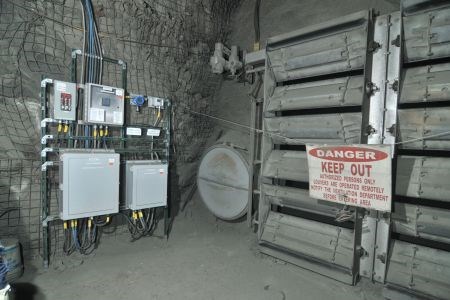Between 2005 and 2009, 176 workers died and another 36 workers developed occupational diseases related to respiratory illnesses in the mining sector, according to the Workplace Safety and Insurance Board (WSIB). The numbers are high, but measures are being taken to reduce the effects of poor air quality underground.
Throughout the months of October and November, the Ministry of Labour made underground mine inspections the target of its safety blitzes, checking to ensure that ventilation systems are being properly maintained and providing an adequate supply of clean air, explained ministry spokesperson William Lin. They also checked that diesel equipment is being properly maintained, and that employers are regularly testing underground air quality.
“Ventilation hazards pose a serious concern in underground mines, many of which operate diesel equipment,” said Lin, noting that guidelines are found in the Occupational Health and Safety Act. “The air in poorly ventilated mines can contain toxins which can cause occupational disease and even death, so it's crucial for worker health and safety that these ventilation systems meet the legislative standards.”
The blitz focused on new or recently opened mines, mines with large fleets of diesel equipment, and mines in which inspectors had previous concerns or had poor compliance histories.
Between January 2009 and March 2011, ministry inspectors issued 79 orders to underground mine operators for not providing adequate ventilation and 35 orders concerning the removal of dust or other hazardous airborne material.
But there are companies that are aiming to stay ahead of the pack. Since 2009, the Centre for Excellence in Mining Innovation (CEMI) in Sudbury has been working with a group of local companies on an $8.5-million ventilation-on-demand (VOD) technology initiative that will not only save on cost, but also improve the health and safety of workers.
Partners include Vale and Xstrata Nickel, Bestech, Simsmart, Objectivity, Symboticware and Caterpillar, as well as the federal government, which kicked in $4.25 million through its Community Adjustment Fund.
“Ventilation on demand is basically putting the quantity of air that you want where you want it in the mine for that duration of time,” explained Glenn Lyle, CEMI's research and development program director.
With ventilation eating up a huge part of the massive energy bill generated by underground mines, constantly running ventilation fans can cost a large mine “several million dollars,” Lyle said, so companies are always seeking the holy grail of mine ventilation: remotely controlled air flow that moves air only where workers are present or activity is taking place.
“You need to be very concerned about ensuring that you still have adequate air flow in all of the areas to protect the workers and to adequately dilute the exhaust from the engines that are working in the area,” Lyle said.
Vale and Xstrata Nickel were already developing VOD technology in their respective mines, but the collaboration with CEMI provided additional testing, monitoring and modelling opportunities.
Researchers wanted to figure out what level of contaminants would be generated for a level of activity, and what level of ventilation would be needed to safely reduce and dilute that quantity of contaminants.
The technology is currently in place at Xstrata Nickel's Nickel Rim South Mine and the 153 ore body at Vale's Coleman Mine, and is already demonstrating “significant benefits,” Lyle said. But there is still more work to be done.
Researchers hope to get more accurate readings from the sensors that monitor air flow, as well as the radio tags that follow equipment. The issue turned out to be more complex than researchers originally thought, since “you're trying to make a variety of systems work together so that you can effectively move the air,” Lyle said.
CEMI is in the process of generating interest amongst other mining companies to get in on the next phase of the project. Lyle believes if the mining industry puts its collective force behind the issue, a resolution can be found.
“The problems are all very similar,” he said. “When they try to implement ventilation on demand they're going to run into some of the same problems that we encountered at Vale and Xstrata, and our pitch to the mining industry is that it's much cheaper and more efficient to try to solve it once and then everyone take advantage of the learnings, rather than each individual company trying to solve the same problem.”
While the CEMI initiative is ahead of the curve, companies eventually may have no choice but to become more stringent in addressing the problem of underground emissions. Companies found to be non-compliant with ministry legislation can face everything from orders to become compliant to charges.
“For each conviction, the court can impose a fine of up to $500,000 against corporations convicted under the Occupational Health and Safety Act,” Lin explained. “Meanwhile, individuals can face a fine of up to $25,000, or imprisonment of up to 12 months, or both.”
But perhaps the real wakeup call is in the 176 deaths and 36 illnesses of workers in Ontario.




